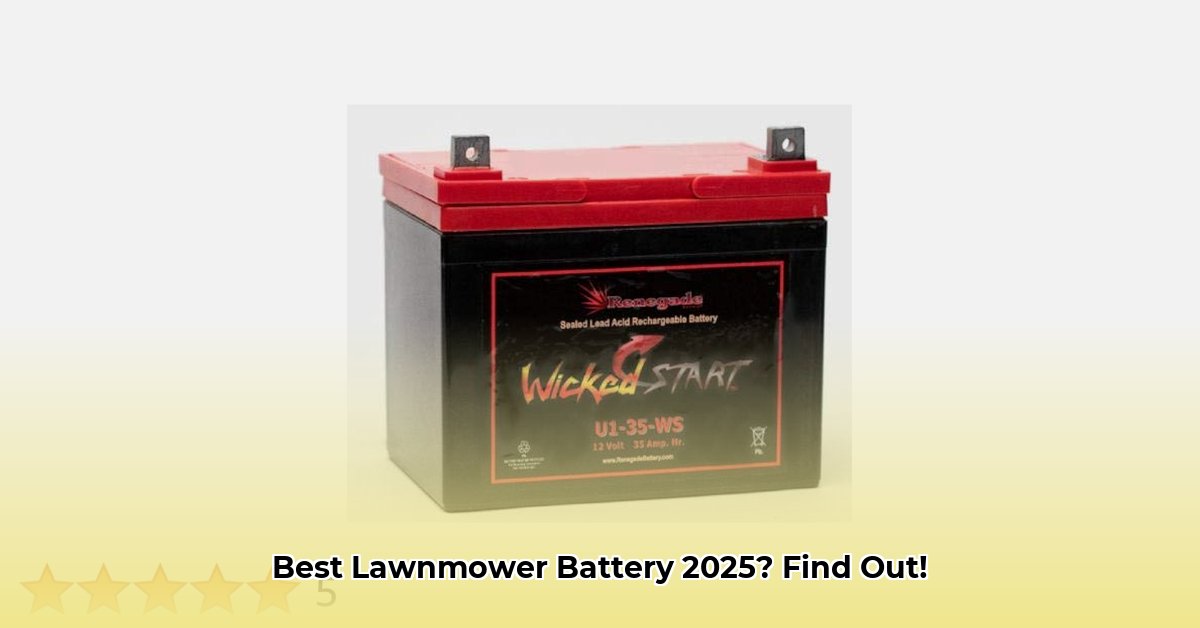
Choosing the right battery for your lawn tractor can be daunting. This guide simplifies the decision, comparing lead-acid and lithium-ion (LiFePO4) batteries to help you find the perfect power source. We'll cover everything from choosing the right battery type to understanding long-term costs and maintenance. For more detailed information on lawn tractor batteries, check out this helpful resource: battery guide.
Understanding Your Needs: Yard Size and Mowing Frequency
Before comparing battery types, consider your mowing habits. How large is your lawn? How often do you mow? Do you frequently mow in extreme temperatures? These factors significantly impact battery choice. A large lawn demands higher amp-hour (Ah) capacity, while smaller yards can manage with less powerful, more budget-friendly options. Frequent mowing requires a durable battery. Extreme temperatures affect both battery performance and lifespan. Isn't it important to choose a battery that can withstand your specific mowing conditions?
Lead-Acid Batteries: The Traditional Choice
Lead-acid batteries are the traditional option, offering a lower upfront cost and readily available replacements. They're reliable for basic needs, but their shorter lifespan and higher maintenance requirements should be considered. Expect a lifespan of roughly two to six years, depending on usage and care. They require regular checks and occasional maintenance, much like a classic car.
Pros of Lead-Acid Batteries:
- Lower initial investment.
- Wide availability—easy to find replacements.
- Relatively straightforward maintenance (though some require regular watering).
Cons of Lead-Acid Batteries:
- Shorter lifespan compared to lithium-ion.
- Requires regular maintenance, including watering (for flooded lead-acid types) and terminal cleaning.
- Poor cold-weather performance.
- Heavier than lithium-ion batteries.
Lithium-ion (LiFePO4) Batteries: The Modern Alternative
Lithium-ion batteries, specifically LiFePO4 (lithium iron phosphate), offer superior performance and longer lifespans compared to lead-acid. They represent a higher upfront investment, but their longevity, minimal maintenance, and excellent cold-weather performance often translate to a lower overall cost of ownership over time. Did you know a LiFePO4 battery can last ten years or more?
Pros of Lithium-ion (LiFePO4) Batteries:
- Extended lifespan (10+ years).
- Low maintenance requirements.
- Excellent cold-weather performance.
- Lightweight and easy to handle.
- Consistent power output.
Cons of Lithium-ion (LiFePO4) Batteries:
- Higher initial cost.
- Requires a compatible charger; they don’t work with standard lead-acid chargers.
- Specialized repair might be more difficult.
Lead-Acid vs. Lithium-ion: A Direct Comparison
This table summarizes the key differences between lead-acid and lithium-ion (LiFePO4) batteries:
| Feature | Lead-Acid | Lithium-ion (LiFePO4) |
|---|---|---|
| Initial Cost | Lower | Higher |
| Lifespan | 2-6 years | 10+ years |
| Maintenance | High | Low |
| Cold Weather Perf. | Poor | Excellent |
| Weight | Heavier | Lighter |
| Overall Cost of Ownership | Higher over time | Lower over time |
Choosing Your Bateria para Tractor Cortacesped: A Step-by-Step Guide
Here's a systematic approach to choosing the right battery:
Step 1: Assess Your Budget: Carefully consider the initial cost and the potential long-term savings of lithium-ion batteries.
Step 2: Evaluate Your Climate: Cold climates favor the superior cold-weather performance of lithium-ion batteries.
Step 3: Consider Mowing Frequency: Frequent use justifies the higher initial cost of a more durable, long-lasting battery.
Step 4: Verify Compatibility: Ensure the battery is compatible with your lawn tractor model.
Step 5: Research Reputable Brands: Choose a reputable manufacturer to ensure quality and reliability.
Step 6: Check Charger Compatibility: If choosing lithium-ion, make sure you have a compatible charger.
Step 7: Review Warranty Information: A longer warranty typically indicates higher product quality and confidence from the manufacturer.
Total Cost of Ownership: A Deeper Dive
The "best" battery isn't always the cheapest upfront. Total cost of ownership (TCO) considers initial cost, lifespan, maintenance, and replacement costs. Often, the higher upfront cost of lithium-ion batteries is offset by their extended lifespan and reduced maintenance, resulting in lower TCO over several years. Wouldn't you agree that minimizing expenses over the long term is crucial?
Calculating Total Cost of Ownership
- Annual Usage: Estimate your yearly lawn tractor usage in hours.
- Battery Lifespan: Estimate the lifespan of each battery type based on your usage and climate.
- Replacement Costs: Calculate the cost of replacements over a set period (e.g., 10 years).
- Maintenance Costs: Include costs for lead-acid maintenance (water, cleaning) versus minimal costs for lithium-ion.
- Compare Total Costs: Add initial cost, replacement costs, and maintenance costs for each battery type to find the overall TCO.
Remember, selecting the ideal bateria para tractor cortacesped requires careful consideration of your budget, mowing habits, and long-term costs. By weighing the advantages and disadvantages of both lead-acid and lithium-ion batteries, you can make an informed decision and enjoy reliable power for years to come.